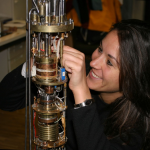

- Photon Transport in a Bose-Hubbard Chain of Superconducting Artificial Atoms
G. P. Fedorov et al., Phys. Rev. Lett. 126, 180503 (2021) - Path-Dependent Supercooling of the
He3 Superfluid A-B Transition
Dmytro Lotnyk et al., Phys. Rev. Lett. 126, 215301 (2021) - Superconductivity in an extreme strange metal
D. H. Nguyen et al., Nat Commun 12, 4341 (2021) - High-Q Silicon Nitride Drum Resonators Strongly Coupled to Gates
Xin Zhou et al., Nano Lett. 21, 5738-5744 (2021) - Measurement of the 229Th isomer energy with a magnetic micro-calorimeter
T. Sikorsky et al., Phys. Rev. Lett. 125 (2020) 142503
Ultralow-Dissipation Superfluid Micromechanical Resonator
F. Souris, X. Rojas, P. H. Kim, J. P. DavisMicro- and nanomechanical resonators with ultralow dissipation have great potential as useful quantum resources. The superfluid micromechanical resonators presented here possess several advantageous characteristics: straightforward thermalization, dissipationless flow, and in situ tunability. We identify and quantitatively model the various dissipation mechanisms in two resonators, one fabricated from borosilicate glass and one from single-crystal quartz. As the resonators are cryogenically cooled into the superfluid state, the damping from thermal effects and from the normal-fluid component are strongly suppressed. At our lowest temperatures, damping is limited solely by internal dissipation in the substrate materials, and the resonators reach quality factors of up to 913 000 at 13mK. By lifting this limitation through substrate-material choice and resonator design, modeling suggests that the resonators could reach quality factors as high as 108 at 100mK, putting this architecture in an ideal position to harness mechanical quantum effects and to facilitate the study of superfluids in confined geometries.
Phys. Rev. Applied 7, 044008 (2017)
doi: 10.1103/PhysRevApplied.7.044008















